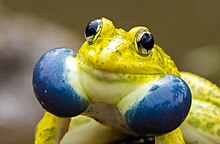Hoplobatrachus tigerinus
| Hoplobatrachus tigerinus | |
|---|---|

| |
| Breeding male | |
| Scientific classification | |
| Domain: | Eukaryota |
| Kingdom: | Animalia |
| Phylum: | Chordata |
| Class: | Amphibia |
| Order: | Anura |
| Family: | Dicroglossidae |
| Genus: | Hoplobatrachus |
| Species: | H. tigerinus
|
| Binomial name | |
| Hoplobatrachus tigerinus (
Daudin , 1803) | |
| Synonyms | |
|
Rana tigerina – Daudin, 1802 | |
Hoplobatrachus tigerinus, commonly known as the Indian bullfrog, is a large species of
Taxonomy
The Indian bulfrog was first described by François-Marie Daudin in 1802, as Rana tigerina.[3] The type locality was given as "Bengale, India". In 1992, it was transferred to the genus Hoplobatrachus by Alain Dubois, as Hoplobatrachus tigerinus. In addition to various other renditions and misspellings of R. tigerina, other synonyms include Rana picta, Dicroglossus tigrinus, and Euphlyctis tigerina.[4]
Description
The Indian bullfrog is a large species of frog. They can grow to be 170 millimetres (6.7 in), with heads generally longer than they are wide, although older individuals tend to have wider heads. Normally green or brown with dark spots, males turn yellow during the breeding season. They tend to have a yellow streak along the spinal region of their back.[5]
Significant variation, in both color and size, exists between different populations, even geographically close ones. A 2012 study found that frogs from different villages in the Jamshoro District of Sindh, Pakistan were consistently different in size and coloration from other local populations. The study suggested that this was caused by food and water quality differences, as well as varying ages.[6]
Their hands are unwebbed, while their feet are essentially fully webbed. Males have
In males, the tympanum is wider than the eye, while in females the eye is wider than the tympanum. Females are also heavier and longer than males.[6]
Distribution and habitat
Distribution
The Indian bullfrog is native to mainland Afghanistan, Bangladesh, India, Myanmar, Nepal, and Pakistan, as well as possibly Bhutan and China, although its presence is uncertain.[1] It has been introduced to Maldives,[1] Madagascar,[7] and India's Andaman Islands, where it is now a widespread invasive species.[8] Likely areas to be invaded in the future include the Mascarene Islands, Malaysia, Indonesia, and East Africa.[9]
Andaman Islands
First reported in October 2011,
One trait in particular that facilitates this invasion is the carnivorous nature of H. tigerinus tadpoles. Experimentation at the Andaman Nicobar Environment Team (ANET) field station on South Andaman Island demonstrated that when kept together in pools with adequate amounts of food, Indian bullfrogs rapidly devoured the tadpoles of native species. This behavior did not appear to increase their growth rate, the time it took to metamorphosize, or adult size. They consumed other tadpoles so quickly that no competitive behavior could be observed between different species. Even when kept only with their own kind, their aggression towards other tadpoles remained, with only three surviving per pool on average (for comparison, when kept without bullfrogs, native tadpoles—of the species Microhyla chakrapanii and Kaloula ghoshi—lived to metamorphosis three out of four times, on average). It is likely that the frog will eventually reach the Nicobar Islands.[11]
Madagascar
The species was first introduced to Madagascar for food, for which it is still used, although it has now become a pest. Human consumption has not been enough to prevent its spread.[1]
Habitat
Hoplobatrachus tigerinus is typically found in freshwater environments, especially
Behavior and ecology

Diet
Adult Indian bullfrogs eat
Reproduction and life cycle
Hoplobatrachus tigerinus reproduce during the
Research
The Indian bullfrog has been found to be an efficient means of controlling mosquito populations.
See also
References
- ^ . Retrieved 20 November 2021.
- ^ "Appendices | CITES". cites.org. Retrieved 2022-01-14.
- ^ Daudin, Francois-Marie (1802). Histoire naturelle des rainettes, des grenouilles et des crapauds. Avec planches (in French). Levrault. p. 64.
- . Retrieved 8 January 2023.
- ^ a b "Hoplobatrachus tigerinus". AmphibiaWeb. Retrieved 21 May 2022.
- ^ ISSN 1813-1743.
- ISBN 978-3-929449-03-7.
- ^ a b Rao, Mohit M. (11 August 2018). "Invasive species, lurking in the Andamans; The Indian bull frog". www.thehindu.com. Archived from the original on 18 December 2018. Retrieved 2018-12-18.
- S2CID 225317846.
- ^ "Combining citizen science and field research to deal with the bullfrog invasion of the Andamans". india.mongabay.com. March 2018. Retrieved 2018-03-09.
- ^ Jain, Neha (13 December 2019). "Invasive bullfrog tadpoles devour native ones in the Andamans". Mongabay. Retrieved 20 May 2022.
- ^ S2CID 12404521. Retrieved 13 July 2022.
- ^ "Estimation of age and longevity of the Indian Bullfrog Hoplobatrachus tigerinus (DAUDIN, 1802): A skeletochronological study" (PDF). 30 December 2005. Retrieved 11 July 2022.
Further reading
- Islam, M. R. and M. B. Hossain. (2012). Genetic variation of three populations of Indian frog (Hoplobatrachus tigerinus) revealed by allozyme marker. International Journal of Zoological Research 8(4) 150-56.
- Kamphon Isarankura na Ayuthaya Nongyao Chanpong Phusati Pariyanonth (Chulalongkorn Univ., Bangkok (Thailand). Faculty of Science. Dept. of Biology). (1989). General morphology and anatomy of frog (Rana tigerina). Thai National AGRIS Centre.

